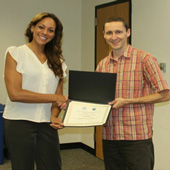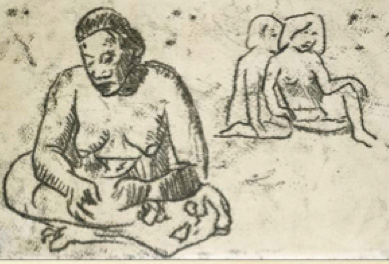RTI and Paul Gauguin: Summer Research for Teachers With NU-ACCESS
 I am a Golden Apple 6th grade Science and Social Studies teacher at Martin Luther King Literary and Fine Arts School here in glorious Evanston, Illinois. This school year I entered my classroom on a cloud of exhilaration over my newly acquired skill-sets and improved confidence from my summer experience with the Research Experience for Teachers (RET) program hosted at Northwestern University and funded by the National Science Foundation. As I embark on my 16th year in School District 65 ready to teach 6th grade Earth Science, Pre-History and Ancient Civilizations for another year, the challenge or fear of being fresh and engaging was nonexistent after experiencing the most amazing summer research program of my life— I actually lived science and experienced life as a research scientist! I was filled with a newness that I hadn’t felt since my 3-hour undergraduate organic chemistry labs at DePaul University trying hard to make acetylsalicylic acid from scratch.
I am a Golden Apple 6th grade Science and Social Studies teacher at Martin Luther King Literary and Fine Arts School here in glorious Evanston, Illinois. This school year I entered my classroom on a cloud of exhilaration over my newly acquired skill-sets and improved confidence from my summer experience with the Research Experience for Teachers (RET) program hosted at Northwestern University and funded by the National Science Foundation. As I embark on my 16th year in School District 65 ready to teach 6th grade Earth Science, Pre-History and Ancient Civilizations for another year, the challenge or fear of being fresh and engaging was nonexistent after experiencing the most amazing summer research program of my life— I actually lived science and experienced life as a research scientist! I was filled with a newness that I hadn’t felt since my 3-hour undergraduate organic chemistry labs at DePaul University trying hard to make acetylsalicylic acid from scratch.
Northwestern University is partnering with the Art Institute of Chicago to conduct research on 19 monotypes and prints by the French Post-Impressionist Paul Gauguin (1848-1903). As part of the research team— led by Drs. Marc Walton, Oliver Cossairt, and Jack Tumblin— I used an advanced imaging technique called Reflectance Transformation Imaging (RTI). RTI combines a number of photographic images of an object taken under different lighting conditions and reconstructs the surface-shape of the object using mathematical estimations of its surface normal vectors (the direction and magnitude of change over the surface). Over the last ten years, the technique has become very popular with the cultural heritage community since the software allows a viewer to dynamically re-light a surface of an artwork (in this case monotype prints on paper) and explore features of manufacture and/or damage.
Our main research objective was to use RTI to characterize the various surface topographies in Gauguin’s prints to better understand his choices in printing inks and how he applied these materials to the paper. Even more impressive, we hoped to be able to discern the chronology of production of his prints based on “blind incisions” embossed into the paper. Blind incisions are imprints made when drawing on a stack of sheets – think of writing on the top sheet in a pad of paper and finding the imprint of your writing on the pages below. As seen in The Sister of Charity monotype, blind incising appears in the pair of women on the right and was transferred to this sheet from a previously drawn composition on the sheet above it on the stack. Many of Gauguin’s prints have similar images making the whole process to decipher them an ultimate detective investigation of the art conservation world!
Another research objective was to examine the quality of the surface normal estimation if a person with zero experience captured the RTI dataset— in other words, me. Dr. Walton gave me a reading assignment, the English Heritage Manual, Multi-light Imaging for Heritage Applications, and I was told to take notes on areas of confusion in the manual and those lacking detailed explanations as I tried to capture RTIs myself. The hope was that my experience would help any newbie, with the same level of trepidation, conduct analysis of a work of art without much effort.
After 4 days of struggling with the manual, I had made it through all the steps and had begun taking my own image sets and processing them for analysis with the RTI software. This task was challenging because it was completely unchartered waters for me and I had to learn how to be fine with failure…often! After 20 captures, I had begun to get the hang of it and thus I was ready for the next task of creating mockups in preparation for analysis of real Gauguin prints. 
The mockups were created on 60 to 80 lb. paper using charcoal pencils and images downloaded and printed from a web search for tracing. I created three mockups for analysis; one is shown here. My responsibilities were to collect data as I worked my way through the English Heritage Manual. I also had to master the “RTI Highlight capture” technique with enough depth so I could teach someone else. A typical day in the lab would require me to set-up objects of various surface textures and capture them using a Canon EOS 4D Digital. Producing sets of images in quantities of 25-60, I took each picture under slightly different lighting conditions by moving a halogen lamp in a dome formation around the object. The reflective target, as seen in Test 9, was a silver ball bearing and was placed directly beside the object of analysis. My computer was loaded with free RTI software (RTIBuilder and RTIViewer) from the Cultural Heritage Imaging website (http://culturalheritageimaging.org/). After I had taken these images they were then loaded into my computer and from there the process that started as a 2-hour capture session was finessed into a 10-minute process of producing useful image sets.
At the end of my experience, I conducted 28 experiments and produced image sets that were sufficient enough for qualitative analysis. I was thrilled to have been a part of this amazing project! I lived the life of a research scientist for 8 glorious weeks. At the end of my experience I felt as if I were a full-fledged contributing member of this team. Also, along the way, I gained a deeper understanding of cultural heritage, art conservation science, and the history of computational imaging. More importantly I made some very great networking connections for my classroom. For example, NU-ACCESS would like to continue to work with my 6th grade students seeing if 11 year olds would be able to conduct RTI analysis on their own works of art! I am a middle school science teacher who can now walk the walk as I steer my young minds into fields of engineering and research! I loved my professional team of art scientists and I will forever be grateful for this learning experience.
